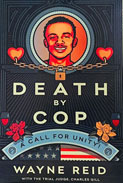
 |
On a December morning in 1998 in the town of New Milford, Connecticut, Franklyn Reid, a Jamaican American, was shot in the back at close range by police Investigator Scott Smith. Prior to the shooting, Franklyn was not committing any crime but was evading the police after being seen walking along the street. Reid died from his wound in the hospital. Smith was able to leave police headquarters without facing the questioning and examination to which a non-police suspect would customarily be subjected. Reid’s family, including his younger brother—the co-author of this stirring account—were shocked, grief-stricken, and enraged by the manner of his sudden death. More than a year later, a trial was held to determine if Smith was guilty of murder. The presiding judge was Gill, who has also contributed his memories and expertise to this legal and personal exploration of events.
Smith’s trial was unique in the state’s history as it was the first time a police officer was charged with committing murder in the line of duty. It came at a time when the American public was becoming more widely alert to the truth of police-on-civilian violence. Local church and community organizations and the NAACP supported the Reid family. At the initial trial, Smith was found guilty of manslaughter and sentenced to a minimum of six years’ imprisonment, but a subsequent retrial allowed him to plead guilty to a misdemeanor, setting him free though never to work in law enforcement again. In 2013, he committed suicide. In that same year, Reid and Gill decided to collaborate on this vivid recounting, combining the agonies felt by Reid and his kin, the complexities of legal jurisprudence, the day-by-day drama of the lengthy trial, and the accompanying media storm.
In such a work as this, though the outcome will be known, what is uncovered in the up-close focus on those involved is insight into individual pain, anger, effort, passion, and courage. Reid and Gill are careful throughout to express a lack of personal animosity toward Officer Smith, who was about the same age as his victim and possibly not as fully trained as he should have been, and they are equally fair-minded in assessing Franklyn Reid, a handsome, gutsy young man whose careless lack of respect for the law had landed him in prison and made him the reasonable object of local police suspicions. Yet within this balanced viewpoint, one critical aspect given particular emphasis in this intensively researched volume is the white officer’s apparent lack of remorse for his deed, which took place only 41 seconds after first accosting his victim, a person of color.
The unique connection to the case by the two authors—one a brother of the victim, the other an honored and respected Connecticut Superior Court judge—has helped in the construction of a cinematic recreation of events based on detailed, factual evidence drawn from police records and courtroom transcripts pertaining to every aspect of the incident and its aftermath. In doing so, they bring to light yet another reason to decry such actions on the part of law enforcement, quietly presenting a plea for further scrutiny in all such cases.
RECOMMENDED by the US Review